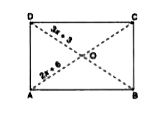The figure, RENT is a rectangle. Its diagonals meet at O. Find x, if OR=2x+4 and OT=3x+1.
To solve the problem, we need to find the value of x given the lengths of the segments OR and OT in the rectangle RENT.
1. Identify the Given Information:
- We have a rectangle RENT.
- The diagonals RT and EN intersect at point O.
- The lengths are given as:
- OR=2x+4
- OT=3x+1
2. Use the Property of Diagonals in a Rectangle:
- In a rectangle, the diagonals bisect each other. Therefore:
- OR=ON
- OT=OE
3. Set Up the Equations:
- Since O is the midpoint, we can write:
- OR=ON implies 2x+4=2x+4 (which is trivially true).
- For the other diagonal:
- OT=OE implies 3x+1=OE.
4. Equate the Lengths of the Diagonals:
- The diagonals of a rectangle are equal in length:
- RT=EN
- This means:
- OR+OT=OR+OE
- Substitute the expressions:
- (2x+4)+(3x+1)=(2x+4)+(3x+1).
5. Simplify the Equation:
- Combine like terms:
- 2x+4+3x+1=5x+5
- Set the equation for the diagonals:
- 5x+5=5x+5 (which is again trivially true).
6. Find the Value of x:
- Since we have established the equality of the segments, we can equate the two expressions:
- 3x+1=2x+4.
- Rearranging gives:
- 3x−2x=4−1
- x=3.
Final Answer:
The value of x is 3.
- We have a rectangle RENT.
- The diagonals RT and EN intersect at point O.
- The lengths are given as:
- OR=2x+4
- OT=3x+1
- In a rectangle, the diagonals bisect each other. Therefore:
- OR=ON
- OT=OE
- Since O is the midpoint, we can write:
- OR=ON implies 2x+4=2x+4 (which is trivially true).
- For the other diagonal:
- OT=OE implies 3x+1=OE.
- The diagonals of a rectangle are equal in length:
- RT=EN
- This means:
- OR+OT=OR+OE
- Substitute the expressions:
- (2x+4)+(3x+1)=(2x+4)+(3x+1).
- Combine like terms:
- 2x+4+3x+1=5x+5
- Set the equation for the diagonals:
- 5x+5=5x+5 (which is again trivially true).
- Since we have established the equality of the segments, we can equate the two expressions:
- 3x+1=2x+4.
- Rearranging gives:
- 3x−2x=4−1
- x=3.
The value of x is 3.
Topper's Solved these Questions
Similar Questions
RENT is a rectangle (Fig 3.41). Its diagonals meet at O. Find x, if OR=2x+4andOT=3x+1
View Solution
In the given figure, the diagonals AC and BD of a rectangle ABCD intersect each other at point O.
If OA=2x+6 and OD=3x+3, find the value of x.
View SolutionThe diagonals of a rectangle ABCD meet at O. If ∠BOC=440, find ∠OAD.
View SolutionThe diagonals of a rectangle ABCD meet at O. If ∠BOC=440, find ∠OAD.
View SolutionThe diagonals of a rectangle ABCD meet at O . If ∠BOC=440, find ∠OAD
View SolutionFind the equations of the circles drawn on the diagonals of the rectangle as its diameter whose sides are x=5, x=−2, y=3 and y=−1.
View SolutionIn Figure, PQRS is a rhombus in which the diagonal PR is produced to T. If ∠SRT=1520, find x, y and z
View SolutionThe diagonals of a rectangle ABCD intersect in O. If ∠BOC=680, find ∠ODA.
View SolutionIn Figure, TQ and TR are the bisectors of ∠Q and ∠R respectively. If ∠QPR=800and ∠PRT=300, determine ∠TQR and ∠QTR
View SolutionShow that the diagonals of a parallelogram divide it into four triangles of equal area. GIVEN : A parallelogram ABCD . The diagonals AC and BD intersect at O. TO PROVE : ar(OAB)=ar(OBC)=ar(OCD)=ar(AOD)
View Solution
